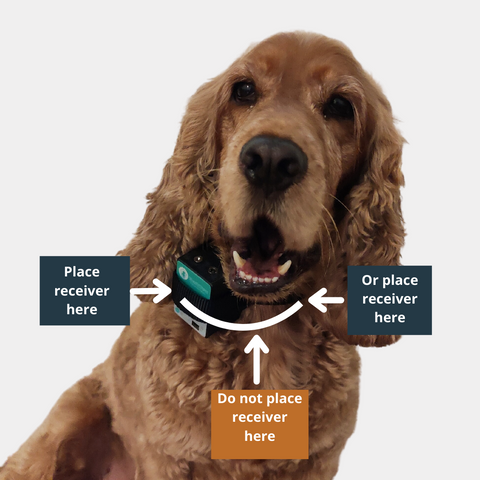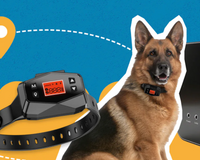Static Bark Collars- The myths explained and debunked for you
As dog owners, we all want the best for our pups, which makes it perfectly normal to be cautious about using a bark collar or dog training collar as part of your training.
There are many reasons why dog parents use a training collar. Many feel like they haven't been getting the results they wanted from their training methods so far, and need another option. Others use it because they know it can be a powerful tool to help teach your dog sound commands.
But once you've been introduced to the world of e-collars, they will become an indispensable tool you'll be thankful to have.
What are bark collars? What are dog training collars?
Bark collars and dog training collars (also referred to as ecollars) are an advanced pet training tool that gently but effectively distracts your dog's behaviour to something else.
We hope by breaking down some common myths around their use and effects, it becomes easier for you to decide if a bark collar is a training tool you're comfortable using.
E-Collars: NOT Your Back-In-The-Day Shock Collars
Before we deep dive in, let's clear the air on bark collars.
Knowing what bark collars are and what they do really helps dog owners like you better understand the device as a valuable dog training tool.
Chances are you've heard 'bark collars' or 'e-collars' referred to as 'shock collars'. But shock collars have a whole history of their own that makes them quite different from modern e-collars.
Most older shock collars used electric shock treatment for behaviour modification, which gave dogs a shock. Modern-day e-collars, on the other hand, use Electronic Stimulation (ES), as a painless alert or distraction to redirect their energy to something else.
How Do Bark Collars Work?
The bark collar aims to effectively distract and interrupt your dog from their current behaviour pattern so you can direct their energy elsewhere. Your dog quickly learns that a distraction will occur when they bark too much or do an unfavourable behaviour.
So if there's one thing to remember about these collars: it's that they are a distraction tool. They do not punish 'bad' behaviours using pain or fear. It's a training tool, and they work best when combined with positive reinforcement training.
Now that you're sitting more on the comfortable scale with e-collars let's get into some myths.
Myth 1: Static Collars Are Painful for Dogs
One thing to remember is that: static shocks are different to electrical shocks.
Both static shock and electric shock have the word "shock", but we assure you they're not the same.
Remember Electronic Stimulation? The type of distraction e-collars' use is an Electronic Stimulation.
A static shock is no different to the "zap" you get from rubbing your feet across a carpet and touching something else after. It's unpleasant for a split moment, but not enough to hurt you.
Here's a comparison between e-collars and other products that also use Electronic Stimulation
for a better idea:
- Muscle toning machines: roughly 2 joules when set on normal, and up to 6 joules when set on high
- Charged, electric security fence (not pet containment unit) : roughly 3.2 joules
- An e-collar / training collar: roughly 0.000005 joules when set on low
*muscle toning machines (often called EMS) are used for power/endurance training, muscle recovery or general muscle toning.
The level of static stimulation in an e-collar is minuscule. So even on the highest setting, static shock isn't powerful enough to inflict pain on your dog.
With that said, some e-collars on the market do not use any form of shock. One example is a Citronella Collar, which uses a brief burst of non-toxic Citronella spray as the deterrent. They're effective because dogs aren't a fan of the Citronella scent!
Many e-collar also come with an audible beep, or vibration as a distraction. And many have found success using these methods.

Myth 2: Static Collars Are Unsafe
Incorrect Usage Makes It Unsafe, Not The Collars!
Just like any training tool, e-collars can become unsafe when used incorrectly.
Once you've understood and implemented proper usage methods, your e-collar is safe; non-painful, and meant to work harmoniously with your dog training needs.
For safe static collar training, you'll want to ensure the following:
1) Appropriate Duration of Wear
An ecollar must never be on for more than 8-10 hours at a time and you should switch the side your dog wears the collar on everyday. This ensures you avoid pressure sores from the contact probes, which are in contact with your dog's skin.

Like many dog owners, if you fear the collar is effective only if on 24/7, just remember:
Initially, the collar has to be on more frequently for the purpose of getting your dog used to the training. But once they've learnt to respond appropriately, you'll rarely have to use the collar! It becomes more of a "maintenance" training tool.
2) Right Fit
Ideally, the collar should sit high on the neck, with the optimal position on either side of the throat.The collar will slip and slide if it's too loose but having it stiff and tight also results in sores and irritation. It should fit snug around your dog's neck, but you should be able to put a "2 finger" space between the collar and your dog.
Remember, if used incorrectly, the e-collar has the potential to become an unsafe and unpleasant experience. If used right, you'll see how responsive your dog becomes, even around the most tempting of distractions.
Myth 3: Static Collars Work Against Positive Reinforcement
e-Collars actually work best when combined with positive reinforcement!
We consider training collars as reinforcement tools. Think of it this way: getting your dog to understand what's a "No" (negative reinforcement) helps them recognise when they're doing the right thing / when a reward is deserved (positive reinforcement).
Professional dog trainers also recommend using e-collars to complement positive reinforcement. Treats, for instance, can be given as encouragement for following collar training instructions. After all, which dog doesn't like to be rewarded for a job well done?
Negative reinforcement is also an important training element because it gives your dog fast, immediate "feedback" that they're not doing the right thing - which methods like positive reinforcement cannot.
You can learn more about why e-collars should be used in conjunction with positive reinforcement here.
Myth 4: Not for Anxious & Fearful Dogs
We might think e-collars are scary from a dog's perspective and, therefore, not effective for naturally fearful or anxious dogs.When used correctly, an e-collar can help interrupt the anxious or fearful state of mind. Going back to what ecollars do, they redirect your dog's current behaviour pattern.
Many dog owners have had their dogs eagerly sit in front of them, waiting for the collar to be put on. This is because they recognise wearing a collar as going outside for play and exercise time - a treat for a dog in boredom!
What Now?
A good takeaway you want to leave with is that static collars are just one of the many dog training tools. Neither positive reinforcement, a leash, or an e-collar should be seen as the ultimate solution to dog training.
As long as you're using them the right way and understand how they help your dog- you can expect e-collars to elevate the behaviour training goals you've set. There are also other Bark Collar options, so you're bound to find one that suits what you're looking for.
Disclaimer :
Remember, eDog Australia and our staff are not dog trainers. We're simply here to provide product advice and occasional educational advice to ensure a smoother, less stressful dog training experience for our customers or interested dog owners alike.











